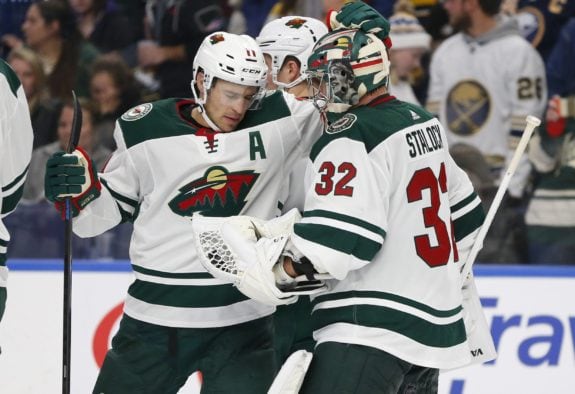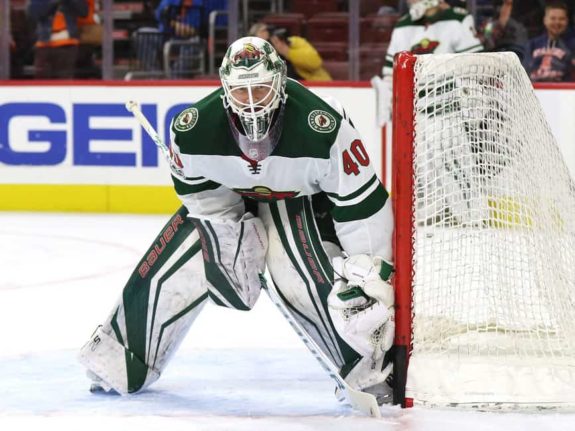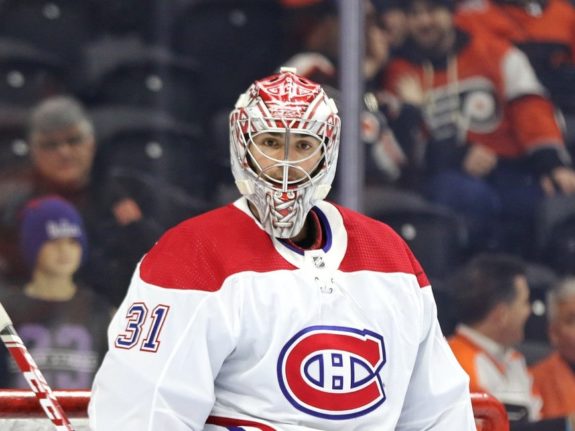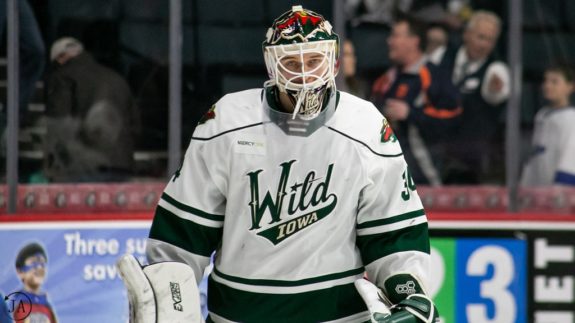The only Minnesota Wild goaltending controversy is that there isn’t one. As long as backup goalie and hometown hero Alex Stalock is getting the job done, he deserves the net. Simple as that.

Stalock vs. Dubnyk
Incumbent No. 1 Devan Dubnyk simply hasn’t done enough to warrant more starts, with his last coming on Feb. 23 against the St. Louis Blues (a loss in which he allowed four goals). Since that point, Stalock, who hails from St. Paul originally, has started five consecutive games, having earned a 4-1 record with one shutout and a .932 save percentage.
It’s a small sample size, but, still compared to Dubnyk, those are masterful numbers. The soon-to-be 34-year-old is 11-15-2 on the season with a 3.34 goals-against average and .892 save percentage. The 32-year-old Stalock (who will be 33 in July) is 19-10 with a 2.59 GAA and .912 save percentage. In effect, the backup has become the starter.

To Stalock’s credit, this is far from the first taste of success he’s had in the NHL. He’s seen NHL action over parts of nine seasons (but always as a backup). Nevertheless, his 12-5-2 2013-14 season with the San Jose Sharks (1.87 GAA, .932 save percentage) hinted at his potential even as a second-stringer.
Of course, Stalock was 26 at that point. He has yet to replicate that same level of success, since. He’s admittedly been solid in a limited role for the Wild, having gone 10-10-4 in 2017-18 for example. However, even this season, overall he’s far from displayed stats on which the Wild should be willing to hang their collective hat.
Stalock’s $785,000 Price Tag
Obviously, the trade deadline has come and gone and the Wild will live or die with the goaltending they currently have. In theory, as long as it’s effective, so be it. In such an instance, there should be no issue moving forward even if you’ve got Dubnyk, with a cap hit of $4.33 million, backing up Stalock, who has one of just $785,000.
Combined, that’s just over $5 million dedicated your goaltending. Teams like the Montreal Canadiens, whose No. 1, Carey Price, makes double that amount on average, should be so lucky. When Canadiens general manager Marc Bergevin says Shea Weber and Carey Price aren’t going anywhere, you can take it to the bank, just for a very different reason. No team would or should want to take on that kind of commitment.

In that sense, the Wild should consider themselves lucky they’ve got Stalock under contract at such a reasonable amount for two more seasons after this one. There’s still no disputing they need Dubnyk to recapture the form he’s displayed over the last five seasons since having been acquired from the Arizona Coyotes. If not, they must look elsewhere as soon as possible for a solution in net, because chances are good Stalock isn’t it.
There are obvious examples of unlikely heroes just like Stalock has the potential to become. For example, Michael Leighton of the 2009-2010 Philadelphia Flyers, who only clinched a playoff berth on the last day of the regular season, helped lead them to the Stanley Cup Final. Closer to home, Iowa Wild alumnus Andrew Hammond posted a 20-1-2 record in 2014-15 out of nowhere to lead the Cinderella Ottawa Senators into the playoffs.
Both these feel-good stories can help to inspire the Wild and Stalock in particular. They have one thing in common, though. Both goalies were flashes in the pan, with Leighton only playing seven more NHL games the rest of his career, which ended in 2016-17. That amounts to an average of one game each season afterwards. Meanwhile, Hammond only got in two playoff games that one spring, before his abrupt fall from grace. The clock always strikes midnight.
All due respect to Stalock, but he has more in common with those two than he does with St. Louis Blues goalie Jordan Binnington. There’s a big difference between Stalock at 32 and the 26-year-old Binnington, who himself is suffering through a bit of a statistical correction just one season after winning the Stanley Cup as an up-to-that-point career minor-leaguer.
Guerin Has Work to Do as Wild GM
All the evidence supports the very realistic thesis that the Wild cannot rest on their laurels and hope Stalock is just a (very) late-bloomer. Either this is simply Dubnyk’s second mid-career crisis, after he once upon a time hit rock bottom by becoming a third-string American Hockey League goalie at age 27, and he eventually snaps out of it or the Wild go looking for more of a long-term solution, because, bless his heart, Stalock should not be GM Bill Guerin’s idea of one.
Thankfully, the Wild’s cupboards are not completely bare. They don’t necessarily need to go shopping for a new goalie on either the trade or free-agent market. For example, they do have goalie Kaapo Kahkonen developing in the AHL as we speak. He’s shown starting potential and is just 23 years old.

The irony of the situation is, unless Dubnyk rediscovers his game, nobody would likely want a 34-year-old goalie on the decline with such a relatively high cap hit. Barring a buy-out, the Wild are stuck with him, and Stalock, in spite of his heroics this season, could end up being the odd man out. If Kahkonen is ready, between him and a career backup, it isn’t exactly a hard decision to make. The Wild could willingly choose to expose the man of the hour to the waiver wire and lose him.
Admittedly, there are far worse problems to have than the relative and cost-effective depth the Wild do in net. There’s a lot with which Guerin can work and no one should feel anything but happy for Stalock for the run he’s on now. He deserves it. However, realistically speaking, this ends with him still playing on his hometown Wild next season, but behind a reinvigorated Dubnyk or as a backup on another team. There’s no salacious headline here other than Stalock successfully standing in for his struggling starter. That’s his job after all. There’s really nothing to see here.